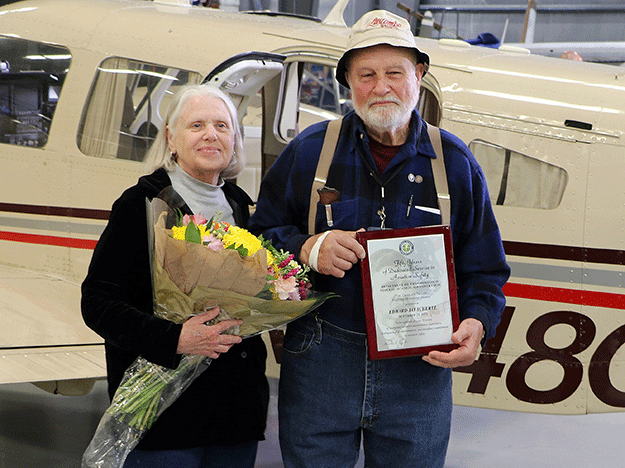On April 26, representatives from the Federal Aviation Administration (FAA) visited the Wings of Hope hangar to present longtime volunteer and former Wings of Hope pilot, Ed Schertz, two of its most coveted awards: The Wright Brothers Master Pilot Award and the Charles Taylor Master Mechanic Award. The awards recognize Ed’s 50 years of dedicated service to safe flying and aircraft maintenance practices.
Ed’s wife, Irene, joined him in accepting the awards as she played an integral role in supporting Ed through his years of flying and service in the field to Wings of Hope.
Ed started flying in 1971, but his career path is unusual. Most pilots start flying humanitarian missions after a career in the military, or as a commercial or private pilot. Except for three summers flying in Alaska for Pacific Airways, Ed spent his entire career flying humanitarian missions for Wings of Hope.
Ed’s Wings of Hope journey started in 1971. He was a student at Southern Illinois University-Carbondale working on earning his pilot’s and mechanic’s licenses so he could work in humanitarian aviation.
“While I was at SIU, Wings of Hope did a presentation,” Ed says. “I liked what I heard, and I contacted Bill Edwards (Wings of Hope co-founder); they were looking for a pilot for Peru, and I said, ‘I’d like to join you.’”
When Ed told the director of the SIU aviation program, Tony DaRosa, that he was interested in joining Wings of Hope, Tony tried to convince Ed to fly for American Airlines.
Ed recalls the conversation going something like this: “I said, ‘Tony, I came to school with something like Wings of Hope in mind.’ Once he knew I was serious and wasn’t changing my mind, he endorsed me. And the rest is history.”
Soon after, he joined Wings of Hope as a pilot and mechanic in Peru in 1971 and ran two field bases in the country until 1978. He and Irene moved to Paraguay with their two young sons, Carlos and Roberto, in 1978 to run Wings of Hope’s base in Pedro Juan Caballero. In 1981, they returned to the states so Ed could be director of maintenance at Wings of Hope’s St. Louis headquarters. Ed stayed in that role through 2005, and he continues to serve the organization as a volunteer mechanic.
In his aviation career, Ed has flown and maintained aircraft in the U.S., Canada, Brazil, Paraguay, Peru, Ecuador, Honduras, Belize, Mexico, Panama, Uruguay, Columbia and Bolivia.
In talking about memorable career moments, Ed recalls loading 100 Rhode Island Red chicks into the cabin of his airplane and flying them to a community in Peru. The idea was to provide the indigenous Ticuna people a renewable food source.
“A year later, we land and there’s nothing but Rhode Island Reds running around,” Ed says. “It was just neat — it changed their quality of life.”
Irene shared the story of being a young mother at home in Iquitos, Peru, with their firstborn son waiting for Ed to arrive after flying missions every day.
“We didn’t have cell phones, radar, no contact with anybody,” she recalls. “He would leave in the morning and come back in the evening.”
And Irene would listen for the sound of Ed’s Cessna landing every night.
Ed flew for the Franciscan missionaries in Peru. They had 12 mission stations that kept in contact with Ed via radio while he was flying. One day, there was a massive thunderstorm that knocked out all radio communication to the mission stations.
That evening, the missionaries came to tell Irene they had lost contact with Ed.
“They told me, ‘We have not heard from the plane; we don’t know where he’s at. We don’t know what’s happened.’”
Irene worried all night.
“The next morning at 10 o’clock, the sun was shining, and he comes down the sidewalk whistling,” says Irene.
When she asked Ed what happened, he said weather got bad — so he landed at one of the missions and spent the night there.
From that point on, Irene changed her mindset: “He goes off, and I don’t worry until I hear from him. That was the only way I could survive anything.”

